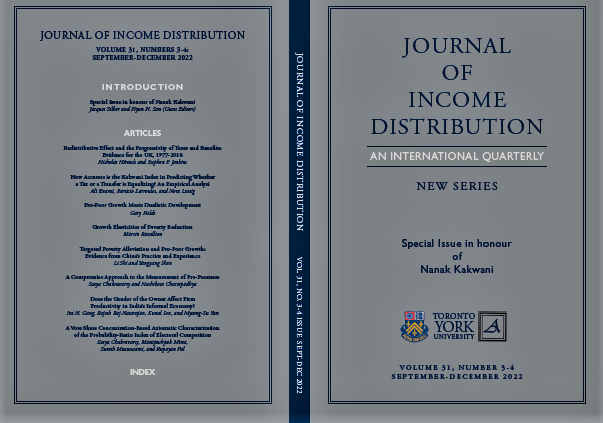Redistributive Effect and the Progressivity of Taxes and Benefits
Evidence for the United Kingdom, 1977–2018
DOI:
https://doi.org/10.25071/1874-6322.40542Keywords:
Kakwani decomposition, inequailty, redistributive effect, progressivity, reranking, benefits, taxesAbstract
We apply the Kakwani approach to decomposing redistributive effect into
average rate, progressivity, and reranking components, using yearly data
from the United Kingdom covering the period of 1977-2018. We examine
cash and in-kind benefits, and direct and indirect taxes. In addition, we
highlight an empirical implementation issue – the definition of the reference
(pre-fisc) distribution. Drawing on an innovative counterfactual approach,
our empirical analysis shows that trends in the redistributive effect of cash
benefits are largely associated with cyclical changes in average benefit rates.
In contrast, trends in the redistributive effects of direct and indirect taxes
are mostly associated with changes in progressivity. For in-kind benefits,
changes in the average benefit rate and progressivity each played major roles
at different times.
References
Aronson, R., P. Johnson, and P.J. Lambert 1994 “Redistributive effect and unequal income tax treatment”, Economic Journal 104: 62–270.
Brewer, M., A. Corlett, K. Handscomb, and D. Tomlinson 2021 The Living Standards Outlook 2021 London: Resolution Foundation.
Canberra Group 2011 Handbook on Household Income Statistics 2nd ed. Geneva: United Nations Economic Commission for Europe.
Hagenaars, A., K. de Vos, and M.A. Zaidi 1994 Poverty statistics in the late 1980s: research based on micro-data Luxembourg: Office for Official Publications of the European Communities.
Hérault, N., and F. Azpitarte 2015 “Recent trends in income redistribution in Australia: Can changes in the tax-benefit system account for the decline in redistribution?”, Economic Record 91(292): 38–53.
Jenkins, S.P. 1988 “Reranking and the analysis of income redistribution”, Scottish Journal of Political Economy 35(1): 65–76.
—– 2022 “Getting the measure of inequality”, IZA Discussion Papers, Number 14996. Bonn: IZA.
—–, and P.J. Lambert 1999 “Horizontal inequity measurement: a basic reassessment” in J. Silber (ed.) Handbook of Income Inequality Measurement Dordrecht: Kluwer. pp. 536-553.
Kakwani, N.C. 1977a “Applications of Lorenz curves in economic analysis”, Econometrica 45: 719–727.
—– 1977b “Measurement of progressivity: an international comparison”, The Economic Journal 87(345): 71–80.
—– 1984 “On the measurement of tax progressivity and redistributive effect of taxes with applications to horizontal and vertical equity”, in R.L. Basmann and G.F. Rhodes (eds.) Advances in Econometrics Volume 3 New York: JAI Press pp. 149–168.
—– 1986 Analyzing Redistribution Policies: A Study Using Australian Data Cambridge: Cambridge University Press.
—–, and Son, H.H. 2021 “Normative measures of tax progressivity: an international comparison”, Journal of Economic Inequality 19(1): 185–212.
Kaplow, L. 1989 “Horizontal inequity: measures in search of a principle”, National Tax Journal 42(2): 139–154.
Kim, K., and P.J. Lambert 2009 “Redistributive Effect of U.S. Taxes and Public Transfers, 1994-2004”, Public Finance Review 37(1): 3–26.
Lambert, P.J. 1985 “On the redistributive effect of taxes and benefits”, Scottish Journal of Political Economy 32(1): 39–54.
—– 1993 The Distribution and Redistribution of Income Manchester: Manchester University Press.
Lerman, R.I., and S. Yitzhaki 1995 “Changing ranks and the inequality impacts of taxes and transfers”, National Tax Journal 48(1): 45–59.
Office for National Statistics 2012 Measuring benefits in kind – methodological changes in the measurement of benefits in kind, 2005/06-2010/11 London: Office for National Statistics.
—– 2016 The effects of taxes and benefits on income inequality: 1977 to financial year ending 2015 London: Office for National Statistics.
—– 2018 Effects of taxes and benefits on UK household income: financial year ending 2017 London: Office for National Statistics.
—– 2019a Effects of taxes and benefits on UK household income: financial year ending 2018 London: Office for National Statistics.
—– 2019b Effects of taxes and benefits on UK household income: financial year ending 2018: technical report London: Office for National Statistics.
—– 2020 Effects of Taxes and Benefits on Household Income Time Series, 2001–2017 [data collection]. Office for National Statistics, [original data producer(s)]. Office for National Statistics. UK Data Service Study Number: 8683 DOI: 10.5255/UKDA-SN-8683-1. [The data for other years have different study numbers (SNs): 2018 (SN 8660), 1977–1993 (SN 7065 to SN 7081); and for 1994 to 2000, SNs 3657, 3780, 3948, 4070, 4398, 4401, and 4577.]
Palme, M. 1996 “Income distribution effects of the Swedish 1991 tax reform: An analysis of a microsimulation using generalized Kakwani decomposition”, Journal of Policy Modeling 18(4): 419–443.
Peichl, A., and P. Van Kerm 2007 “PROGRES: Stata module to measure distributive effects of an income tax” Statistical Software Components S456867, Boston College Department of Economics. https://ideas.repec.org/c/boc/bocode/s456867.html
Pfähler, W. 1983 “Measuring redistributional effects of tax progressivity by Lorenz curves” Jahrbücher für Nationalökonomie und Statistik 198(3): 237–249.
Pope, T., and T. Waters 2016 “A survey of the UK tax system” Briefing Note 9 (revised) London: Institute for Fiscal Studies.
Suits, D. B. 1977 “Measurement of tax progressivity”, American Economic Review 67(4): 747–752.
Thomas, A. 2021 “Reassessing the regressivity of the VAT”, Fiscal Studies, online ahead of publication, DOI: 10.1111/1475-5890.12290.
Urban, I. 2008 “Income redistribution in Croatia: the role of individual taxes and social transfers”, Financial Theory and Practice 32(3): 387–403.
—– 2009 “Kakwani decomposition of redistributive effect: origins, critics and upgrades” Society for the Study of Economic Inequality Working Paper No. 148.
—– 2014 “Contributions of taxes and benefits to vertical and horizontal effects” Social Choice and Welfare 42(3): 619–645.
Webber, D., R. Tonkin, and M. Shine 2020 “Using tax data to better capture top incomes in official UK income inequality statistics” in R. Chetty, J.N. Friedman, J.C. Gornick, B. Johnson, and A. Kennickell (eds.) Measuring and Understanding the Distribution and Intra/Inter-Generational Mobility of Income and Wealth. Cambridge, MA: National Bureau of Economic Research, forthcoming. https://www.nber.org/books/chet-1
Verbist, G., and F. Figari 2014 “The redistributive effect and progressivity of taxes revisited: an international comparison across the European Union”, Finanzarchiv 70(3): 405–429.





